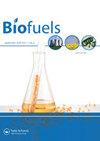植物微生物燃料电池中电极材料的评价:石墨和不锈钢的比较
IF 2.6
4区 工程技术
Q3 ENERGY & FUELS
引用次数: 0
摘要
本文章由计算机程序翻译,如有差异,请以英文原文为准。
Electrodes materials evaluation in plant microbial fuel cells: a comparison of graphite and stainless steels
Abstract The plant microbial fuel cell (PMFC) is an unexpected source of electricity. However, several constraints must be overcome before PMFC can be used as a bioelectricity source. One of the major challenges is to improve electrode performance. In this study, three types of electrodes were tested on PMFC planted with chlorophytum sp, two are made of stainless steel (SS) 436, (SS) 316 and the third is with graphite. The plant with graphite has showed a high tension OCV (400 mV) compared to SS 436 (106 mV) and SS 316 (150 mV), by investing further, the chronoamperometry had shown a more significant current 2 A/m2 with graphite electrode than SS 316 with maximal value 0.12 A/m2 while the SS 436 electrode had metal deterioration, this was later confirmed by a Tafel test, in which SS 436 had the highest current corrosion density. As expected, the maximum current and power densities of PMFC with graphite electrode achieved 20.4 mA/m2 and 37 µW/m2 respectively that were higher than that densities of the PMFC with SS 316 (5.33 mA/m2 and 23 µW/m2) and the PMFC with SS 436 (2.2 mA/m2 and 10.5 µW/m2). According to the finding of this study, graphite was found to be the most suitable electrode material for PMFC application using rhizospheric soil.
求助全文
通过发布文献求助,成功后即可免费获取论文全文。
去求助
来源期刊

Biofuels-Uk
Energy-Renewable Energy, Sustainability and the Environment
CiteScore
5.40
自引率
9.50%
发文量
56
期刊介绍:
Current energy systems need a vast transformation to meet the key demands of the 21st century: reduced environmental impact, economic viability and efficiency. An essential part of this energy revolution is bioenergy.
The movement towards widespread implementation of first generation biofuels is still in its infancy, requiring continued evaluation and improvement to be fully realised. Problems with current bioenergy strategies, for example competition over land use for food crops, do not yet have satisfactory solutions. The second generation of biofuels, based around cellulosic ethanol, are now in development and are opening up new possibilities for future energy generation. Recent advances in genetics have pioneered research into designer fuels and sources such as algae have been revealed as untapped bioenergy resources.
As global energy requirements change and grow, it is crucial that all aspects of the bioenergy production process are streamlined and improved, from the design of more efficient biorefineries to research into biohydrogen as an energy carrier. Current energy infrastructures need to be adapted and changed to fulfil the promises of biomass for power generation.
Biofuels provides a forum for all stakeholders in the bioenergy sector, featuring review articles, original research, commentaries, news, research and development spotlights, interviews with key opinion leaders and much more, with a view to establishing an international community of bioenergy communication.
As biofuel research continues at an unprecedented rate, the development of new feedstocks and improvements in bioenergy production processes provide the key to the transformation of biomass into a global energy resource. With the twin threats of climate change and depleted fossil fuel reserves looming, it is vitally important that research communities are mobilized to fully realize the potential of bioenergy.
 求助内容:
求助内容: 应助结果提醒方式:
应助结果提醒方式:


